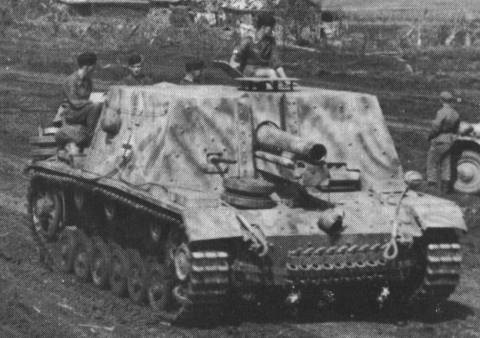|
|
|
Sturm-Infanteriegeschutz 33

German
Sturm-Infanteriegeschutz 33
Based on the Panzerkamfwagen III , the StuG III was the most successful German assault gun . Armed with a short-barreled 75mm gun and protected by thick armor , the StuG III broke havoc into the French lines in 1940 . As the war progressed , because of the growing demand for more anti-tank weapons , late versions of the StuG III were armed more like tank destroyers rather than assault guns . Consequently , it was decided to use the StuG III's chassis and larger guns in order to create the new generation of assault guns : the Sturmpanzers ( Mobile Artillery ).
The first in this serie , the Sturm-Infanteriegeschutz 33 ( Stug 33 ) was a heavy infantry gun carrier designed and produced by Alkett . Its design was based on StuG III Ausf B's chassis , while production models on StuG III Ausf E and F/8's chassis . It was armed with a 150mm sIG 33 L/11.4 heavy infantry gun . Against infantry attacks , the Stug 33 had a 7.92mm MG34 machine gun , mounted in a ball mount in the front superstructure . The side superstructure plates had pistol ports and two submachine gun ( 9mm MP38 ) were issued to the crew for local defence . Storage space allowed only 30 rounds for the 150mm gun and 600 rounds for the MG to be carried inside the vehicle . The Stug 33 was operated by a crew of 5 .
From December 1941 to October 1942 , a total number of 24 were produced . All of the vehicules were used exclusively on the Eastern Front .12 of them equipped Sturmgeschutz Abteilung 177 , and they were all lost in the streets of Stalingrad . The other 12 were used by Sturm-Infanteriegeschutz-Batterie Lehr Battalion XVII for training purposes .
By Pz_Tobruk
.
Crew: 5 (commander, gunner, loader, driver and radio operator)
Weight: 21.0 tons
Dimensions: 5.40 x 2.90 x 2.30
Armor (max):80 mm
Range: 85 km
Speed (max):20.0 km/hr
Main gun: 105 mm L/11
No. Produced: 24
